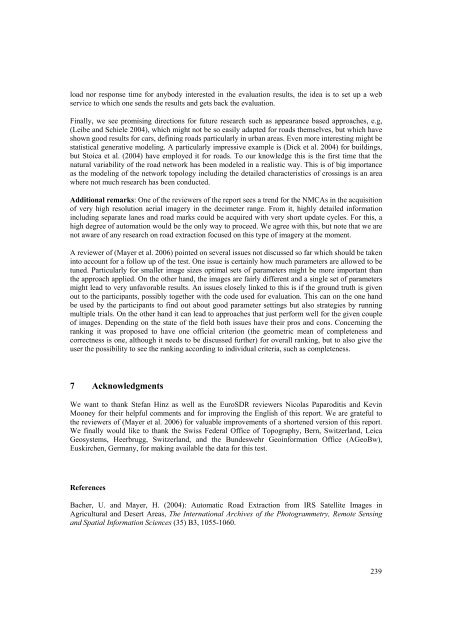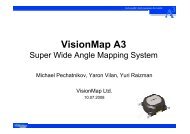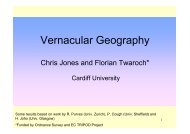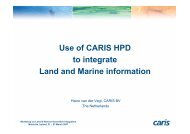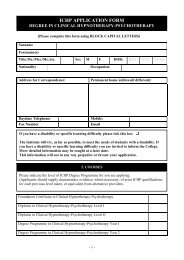EuroSDR Projects - Host Ireland
EuroSDR Projects - Host Ireland
EuroSDR Projects - Host Ireland
You also want an ePaper? Increase the reach of your titles
YUMPU automatically turns print PDFs into web optimized ePapers that Google loves.
load nor response time for anybody interested in the evaluation results, the idea is to set up a web<br />
service to which one sends the results and gets back the evaluation.<br />
Finally, we see promising directions for future research such as appearance based approaches, e.g,<br />
(Leibe and Schiele 2004), which might not be so easily adapted for roads themselves, but which have<br />
shown good results for cars, defining roads particularly in urban areas. Even more interesting might be<br />
statistical generative modeling. A particularly impressive example is (Dick et al. 2004) for buildings,<br />
but Stoica et al. (2004) have employed it for roads. To our knowledge this is the first time that the<br />
natural variability of the road network has been modeled in a realistic way. This is of big importance<br />
as the modeling of the network topology including the detailed characteristics of crossings is an area<br />
where not much research has been conducted.<br />
Additional remarks: One of the reviewers of the report sees a trend for the NMCAs in the acquisition<br />
of very high resolution aerial imagery in the decimeter range. From it, highly detailed information<br />
including separate lanes and road marks could be acquired with very short update cycles. For this, a<br />
high degree of automation would be the only way to proceed. We agree with this, but note that we are<br />
not aware of any research on road extraction focused on this type of imagery at the moment.<br />
A reviewer of (Mayer et al. 2006) pointed on several issues not discussed so far which should be taken<br />
into account for a follow up of the test. One issue is certainly how much parameters are allowed to be<br />
tuned. Particularly for smaller image sizes optimal sets of parameters might be more important than<br />
the approach applied. On the other hand, the images are fairly different and a single set of parameters<br />
might lead to very unfavorable results. An issues closely linked to this is if the ground truth is given<br />
out to the participants, possibly together with the code used for evaluation. This can on the one hand<br />
be used by the participants to find out about good parameter settings but also strategies by running<br />
multiple trials. On the other hand it can lead to approaches that just perform well for the given couple<br />
of images. Depending on the state of the field both issues have their pros and cons. Concerning the<br />
ranking it was proposed to have one official criterion (the geometric mean of completeness and<br />
correctness is one, although it needs to be discussed further) for overall ranking, but to also give the<br />
user the possibility to see the ranking according to individual criteria, such as completeness.<br />
7 Acknowledgments<br />
We want to thank Stefan Hinz as well as the <strong>EuroSDR</strong> reviewers Nicolas Paparoditis and Kevin<br />
Mooney for their helpful comments and for improving the English of this report. We are grateful to<br />
the reviewers of (Mayer et al. 2006) for valuable improvements of a shortened version of this report.<br />
We finally would like to thank the Swiss Federal Office of Topography, Bern, Switzerland, Leica<br />
Geosystems, Heerbrugg, Switzerland, and the Bundeswehr Geoinformation Office (AGeoBw),<br />
Euskirchen, Germany, for making available the data for this test.<br />
References<br />
Bacher, U. and Mayer, H. (2004): Automatic Road Extraction from IRS Satellite Images in<br />
Agricultural and Desert Areas, The International Archives of the Photogrammetry, Remote Sensing<br />
and Spatial Information Sciences (35) B3, 1055-1060.<br />
239


